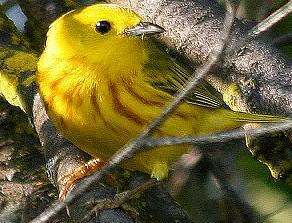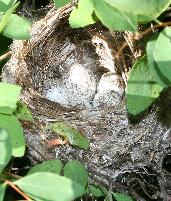 Warbler Warbler

Identification and Pictures
Yellow Warbler (Dendroica
petechia)
Warblers are small very active birds,
about 4 1/2 to 5 1/4 inches, with thin pointed bills in the Passerine family.
There are a quite a few different warblers. The most wide spread and
brightly colored is the Yellow warbler.

The Yellow
warble is the most yellow of all the warblers. The male shown here has red streaks on his breast.
The females and young are not as bright, and if they have streaks they are not as pronounced as the
male.
Photos by Keith Lee. The
camera I use is the Canon
EOS 40D. Visit All-birds store Other common warblers
are Yellow-throated warbler, Wilson's, Prairie and Orange-crowned
warbler. One of the easiest ways to tell most warblers apart is with the head pattern.
Sound of WarblersThe song of the Yellow warbler is musical, and sounds like sweet-sweet-sweet, I'm sweet.
Their call sounds like ship or chip.
Wilson's warbler song is quick chatter notes, which lower in pitch near the end.
They have a call that sounds like "chip" with kind of a nasal quality.
The song of the Orange-Crowned warbler is a fast trill like chip-ee,
chip-ee, chip-ee, and a fast chip call.
Prairie warbler's sing a buzzy zee zee zee. Their call sounds like
"chip"
Warbler sounds:
Preferred Habitat
Yellow warblers have a wide range from Alaska across Canada, and the U.S., and into South America.
They like willows, poplars, brushy areas, and thick vegetation near streams, and forests edges, where they forage in the vegetation for small insects.
They are also often seen in shade trees in cities. When they migrate south in the winter they can be found in open tropical habitats.
Orange-Crowned Warblers inhabit brushy
woodlands, and undergrowth. They like willows, and
aspens. They can be found in Alaska, Canada, and across
the U.S.
Wilson's warbler likes areas along woodland
streams with low shrubs, and willows. They can be
found in Alaska, Canada, and across the U.S.
Prairie warblers like low shrubs and early
growth forests.
Breeding and Nesting 
Female Yellow Warblers usually arrive at the breeding grounds a few days after the males,
and they will bond into pairs. She will
build a cup sized nest of grass, stem fibers, and plant down, lined plant down or other soft
materials, and may be held together with webbing from
caterpillar nests. It is usually placed in low shrubbery.
Warblers are one many birds that are parasitized by Brown-headed
cowbirds. Cowbirds will lay their eggs in the nest of other
birds, so the host bird will raise it's young. Warblers will often build one or more new nests on top of a nest with
cowbird eggs in it.  Their
eggs can be gray, pink, or greenish white. They are speckled with
grayish or purple spots which often form a band around the larger end. Their
eggs can be gray, pink, or greenish white. They are speckled with
grayish or purple spots which often form a band around the larger end.
Food & feeding
Insects and spiders are Warbler's main diet
however they will visit suet feeders.
For more on food
and feeding click here.
For more on feeders click here.
To learn about other favorite
birds click here.

|
